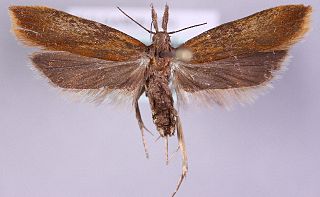
Urodidae, whose species are commonly known as false burnet moths, is a family of moths in the lepidopteran order. It is the type genus in the superfamily, Urodoidea, with three genera, one of which, Wockia, occurs in Europe.

Sematurinae is a subfamily of moths in the family Sematuridae represented by at least 29 species in the Neotropics.

Spilosoma urticae, the water ermine, is a moth of the family Erebidae. It is found in temperate belt of the Palearctic realm like similar Spilosoma lubricipedum, but prefers drier biotopes. So, S. urticae is more abundant in steppes and it is the single Spilosoma species in Central Asia.
Amblygonia is a synonym of the moth genus ParcellaStichel, 1910 of the family Noctuidae. It is listed as a genus on Butterflies and Moths of the World.
Goniocraspedon is a genus of moths of the family Erebidae described by George Hampson in 1993.
Celonoptera is a monotypic moth genus in the family Geometridae. Its only species, Celonoptera mirificaria, is found in south-eastern Europe. Both the genus and species were first described by Julius Lederer in 1862.
Ithysia is a monotypic moth genus in the family Geometridae. Its only species is Ithysia pravata. The genus was erected by Jacob Hübner in 1825, but the species had been first described by Hübner in 1813.
Panagropsis is a monotypic moth genus in the family Geometridae described by Warren in 1894. Its only species, Panagropsis equitaria, described by Francis Walker in 1861, is found in South Africa.
Paraboarmia is a monotypic moth genus in the family Geometridae erected by F. Krampl in 1994. Its only species, Paraboarmia viertlii, the Bohatsch's lined, first described by Otto Bohatsch in 1883, is found in Europe.
Spartopteryx is a monotypic moth genus in the family Geometridae erected by Achille Guenée in 1858. Its only species, Spartopteryx kindermannaria, was first described by Otto Staudinger in 1871.
Spectroreta is a monotypic moth genus belonging to subfamily Drepaninae erected by Warren in 1903. Its only species, Spectroreta hyalodisca, was described by George Hampson in 1896.
Sorocaba is a monotypic moth genus of the family Phiditiidae. Its only species, Sorocaba anomala, is found in São Paulo, Brazil. Both the species and genus were described by Frederic Moore in 1882.

Cyme sexualis is a moth of the subfamily Arctiinae first described by Felder in 1864. It is found on Ambon, Sulawesi, the Dampier Archipelago. and in New Guinea.
Phoenicoprocta vacillans is a moth in the subfamily Arctiinae. It was described by Francis Walker in 1856. It is found in Colombia and the Brazilian states of São Paulo and Santa Catarina.
Amastus modesta is a moth in the family Erebidae. It was described by Peter Maassen in 1890. It is found in Bolivia.
Bucculatrix paliuricola is a moth in the family Bucculatricidae. It was described by Vladimir Ivanovitsch Kuznetzov in 1960. It is found in Turkmenistan and Ukraine.

Dichomeris ustalella is a moth in the family Gelechiidae. It is found in south-eastern Siberia, the Caucasus, Transcaucasia, Korea, Japan, China and Europe, where it has been recorded from most of the continent, except for Ireland, the Iberian Peninsula and Scandinavia.

Helcystogramma lutatella, the clay crest, is a moth in the family Gelechiidae. It was described by Gottlieb August Wilhelm Herrich-Schäffer in 1854. It is found in Uralsk, Transbaikalia, China and almost all of Europe.






